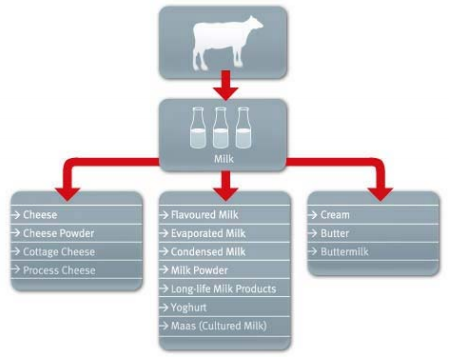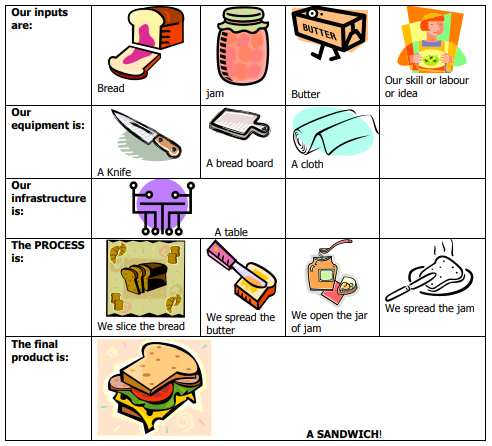Animal production provides human society with a myriad of useful products. However, these products are not only provided to the consumer in their raw form, they are often processed in some manner. Processing changes the raw product in some way that may be more convenient for the consumer, it may make the product safer for the consumer to consume, or it may make the product more attractive to the consumer. The diagram below shows all the dairy products that can be made from cow’s milk. Other products such as cosmetics and soap can also be made from cow’s milk.

Value-adding or processing requires inputs, equipment, infrastructure and safety. This means that if you add these things to a raw product a secondary product is produced. Let’s see what this means. We’ll make a sandwich together...

Thus, the making of the sandwich is the PROCESS by which we change the inputs into the final product utilising the equipment and infrastructure. We are, through our labour and the use of various inputs, equipment and infrastructure, adding value to our raw ingredients (in this case the “raw ingredients” are secondary products of agriculture: bread, jam and butter – products from value-adding to the primary products wheat, fruit and milk).
All consumers have certain quality expectations from agricultural products. Quality characteristics may refer to colour (sight), flavour (taste), texture (touch), smell (nasal), strength, tenderness, and so on.
Most importantly, when considering food products, safety is an important consideration by consumers. This is because, each year, an estimated 76 000 000 people experience a foodborne infection in the United States; 325 000 are hospitalised and 5 000 dies. The annual patient-related costs of just the principal bacterial and parasitic food borne infections have been estimated at $6,5 billion or more (Buzby and Roberts,1996). To this can be added lost wages, product recalls and other social costs.
Among the established foodborne infections, bacterial infections account for an estimated 30% of cases, 63% of hospitalisations and 72% of deaths. Five food borne pathogens namely;
- E. coli 0157: H7;
- Salmonella;
- Campylobacter;
- Listeria; and
- Toxoplasma,
Click here to view a video that explains foodborne diseases.
Together with the above cause an estimated 35 000 000 cases; 33 000 hospitalisations and 1600 deaths each year.
Effective control of many foodborne infections ultimately depends on designing food production and processing for safety.